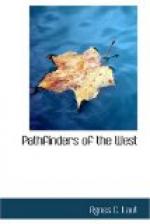[8] This practice was a binding law on many tribes. Catlin relates it of the Mandans, and Hearne of the Chipewyans. The latter considered it a crime to kiss wives and children after a massacre without the bath of purification. Could one know where and when that universal custom of washing blood-guilt arose, one mystery of existence would be unlocked.
[9] I have throughout followed Mr. Sulte’s correction of the name of this governor. The mistake followed by Parkman, Tanguay, and others—it seems—was first made in 1820, and has been faithfully copied since. Elsewhere will be found Mr. Sulte’s complete elucidation of the hopeless dark in which all writers have involved Radisson’s family.
[10] If there were not corroborative testimony, one might suspect the excited French lad of gross exaggeration in his account of Iroquois tortures; but the Jesuits more than confirm the worst that Radisson relates. Bad as these torments were, they were equalled by the deeds of white troops from civilized cities in the nineteenth century. A band of Montana scouts came on the body of a comrade horribly mutilated by the Indians. They caught the culprits a few days afterwards. Though the government report has no account of what happened, traders say the bodies of the guilty Indians were found skinned and scalped by the white troops.
[11] Radisson puts the Senecas before the Cayugas, which is different from the order given by the Jesuits.
[12] The fact that Radisson confessed his sins to this priest seems pretty well to prove that Pierre was a Catholic and not a Protestant, as has been so often stated.
CHAPTER II
1657-1658
RADISSON’S SECOND VOYAGE
Radisson returns to Quebec, where he joins the Jesuits to go to the Iroquois Mission—He witnesses the Massacre of the Hurons among the Thousand Islands—Besieged by the Iroquois, they pass the Winter as Prisoners of War—Conspiracy to massacre the French foiled by Radisson.
From Amsterdam Radisson took ship to Rochelle. Here he found himself a stranger in his native land. All his kin of whom there is any record—Pierre Radisson, his father, Madeline Henault, his mother, Marguerite and Francoise, his elder and younger sisters, his uncle and aunt, with their daughter, Elizabeth—were now living at Three Rivers in New France.[1] Embarking with the fishing fleet that yearly left France for the Grand Banks, Radisson came early in the spring of 1654 to Isle Percee at the mouth of the St. Lawrence. He was still a week’s journey from Three Rivers, but chance befriended him. Algonquin canoes were on the way up the river to war on the Iroquois. Joining the Indian canoes, he slipped past the hilly shores of the St. Lawrence and in five days was between the main bank on the north side and the muddy shallows of the Isle of Orleans. Sheering out where the Montmorency roars over a precipice in a shining cataract, the canoes glided across St. Charles River among the forests of masts heaving to the tide below the beetling heights of Cape Diamond, Quebec.




